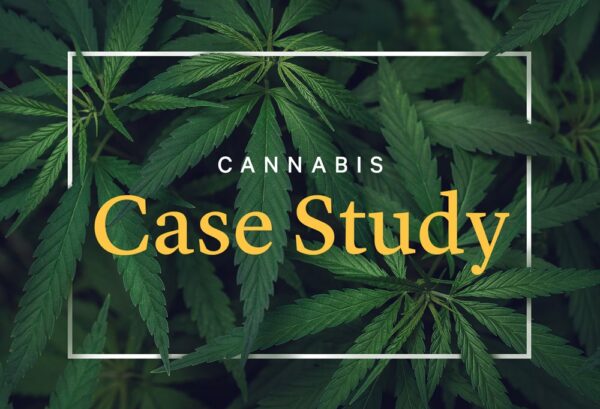
Introduction
Patient demographic
43 year old male with chronic pancreatitis
Case Presentation
Medical History and Allergies
- History of chronic pancreatitis, epilepsy, and insomnia. His medical conditions are controlled with prescription medications.
- Currently taking opioids every 4 hours for the pain related to pancreatitis
- No Known Drug Allergies
Medications:
Keppra, Zenpep, Trazadone and Oxycodone
Illicit substances or alcohol use:
Alcohol at social events. No illicit substances outside of his history.
History of Cannabis use:
The patient started smoking cannabis in his teenage years and has over 20 years’ experience medicating with cannabis. He prefers inhaled cannabis products as an alternative to prescription pain management due to the side effects.
Chief complaint(s):
Abdominal pain which is described as inflammation based. He was diagnosed with chronic pancreatitis years ago and using prescription medications to help with pain. Patients’ quality of life is lowered due to discomfort and looking to help improve his mood. He does not want to continue purchasing cannabis outside of a dispensary due to chances of the medication being contaminated with fentanyl.
Restrictions of use (personal and DOH):
No restrictions per DOH, patient is willing to try all forms of consumption. He prefers some type of inhalation method since he has experience.
Management
Formulation (s):
- Ilera Ease 1:10 tincture (THC: 0.5 mg/ml, CBD: 4.8 mg/ml), started with 0.25ml (0.125 mg THC/1.25 mg CBD), titrated up to 0.5ml (0.5 mg THC/2.5mg CBD).
- Ilera Pain Killer disposable pen (THC 40%, CBD 10%)
Dose:
- Tincture: start with 0.25mL, can increase by 0.25mL every 3 days until effective dose is reached.
- Disposable pen: Take one inhalation and wait 30 minutes before re-dosing. Use as needed for breakthrough pain.
Frequency:
- Tincture: Start with sublingual once a day, can increase to twice a day once an effective dose is reached.
- Disposable pen: Use as needed for breakthrough pain, wait 30 minutes between inhalations.
Other comments:
It is best to wait at least four hours when taking Trazadone or Oxycodone when utilizing cannabis concurrently due to the potential drug interaction and potential increased side effects. In these cases, we recommend that the patient work with their physician to space out their prescription medication with cannabis by at least 2 hours. Due to the sedative properties of Trazadone, it’s better to see how cannabis works since it too is used as a sedative. This gives the patient the ability to see the effects of cannabis alone, and eventually help titrate off the medication. Also allowing a four-hour window can lower the amount of oxycodone used in a day. Most patients look to use cannabis as an alternative for their pain management. The patient was educated on inhalation technique and draw times. Often there is confusion with draw times and inhaling the medicine. Some patients will draw the medication into their mouth but not actually inhale the medication.
Outcome
The patient has used cannabis in the past to help with his pain, however he stopped because he was once giving cannabis, purchased from the street, containing fentanyl. He was not aware until his medical provider noticed in is lab results. The patient was educated on the regulations from the Department of Health and how medicines do not reach the dispensary unless they pass testing. He was instructed to start with a CBD dominate tincture to help with the inflammation. The tincture can be used for long-acting relief and disposable pen for short acting. A titration schedule was given to the patient to reach an effective dose of 0.5ml daily. The disposable pen was used up to 3 times a day with one inhalation per use. No side effects were reported with either form. He reports using his opioid regimen 3-4 times a day which is a step down from his every 4-hour schedule. The patient feels it’s less stressful now that he has an alternative option to his pain management.
Discussion
The patient reported chronic pancreatitis, currently being treated with opioids. Due to the side effects, alternative therapy was investigated. Based on the patient’s description of pain, a pharmacist can recommend between using a THC dominate or CBD dominate therapy. Due to nature of the disease states, a CBD-dominate tincture was started at 0.25ml (1.2mg CBD/ 0.125mg THC) daily. The patient was instructed to slowly increase the dose every 3 days by 0.25mL (1.2mg CBD/ 0.125mg THC) until an effective dose is reached. As the patient reached an effective dose of 0.5ml (2.4mg CBD/0.25mg THC) twice a day, he used the disposable pen once or twice a day and felt improvement in his abdominal area. Disposable pens can be convenient for patients who experience break through pain and need immediate relief. The patient also noted a decrease in his opioid use which was the goal to therapy. Measuring adherence to opioids is one way to get more objective information on cannabis efficacy.
Pain management is common with medical cannabis and patients can be treated with a range of therapies. Patients benefit from a tincture because the dose of cannabinoids is calculated. All tinctures have concentrations on the label and come with a 1ml dropper (4 x 0.25mL increments). With a measured volume and known concentration, a THC dose can be calculated. Although inhalation methods bypass most of the liver, there are still many variables (draw time, device, technique) which make exact dosing difficult. With cannabis, the patient now has an alternative option to help with his pain and hopes to replace his prescription medication.
Come visit a SF Bay Area Apothecarium dispensary near me at our Castro dispensary, Berkeley dispensary, Marina dispensary, Soma dispensary and Capitola dispensary locations in San Francisco California.
If you are visiting our other locations in Pennsylvania and New jersey you might want to see what we have at our Phillipsburg dispensary, Maplewood dispensary and the Lodi dispensary in NJ. Or check out our Pennsylvania locations at our Lancaster dispensary, Thorndale dispensary and the Plymouth Meeting dispensary in PA.

